
Danish is a North Germanic language from the Indo-European language family spoken by about six million people, principally in and around Denmark. Communities of Danish speakers are also found in Greenland, the Faroe Islands, and the northern German region of Southern Schleswig, where it has minority language status. Minor Danish-speaking communities are also found in Norway, Sweden, the United States, Canada, Brazil, and Argentina.
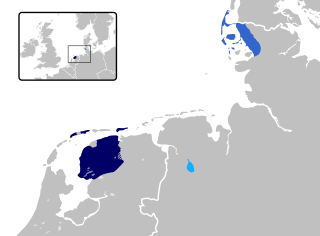
The Frisian languages are a closely related group of West Germanic languages, spoken by about 400,000 Frisian people, who live on the southern fringes of the North Sea in the Netherlands and Germany. The Frisian languages are the closest living language group to the Anglic languages; the two groups make up the Anglo-Frisian languages group and together with the Low German dialects these form the North Sea Germanic languages. However, modern English and Frisian are not mutually intelligible, nor are Frisian languages intelligible among themselves, owing to independent linguistic innovations and foreign influences.
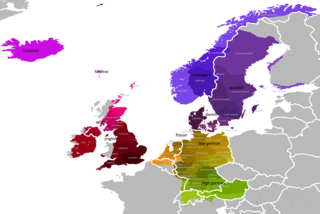
The Germanic languages are a branch of the Indo-European language family spoken natively by a population of about 515 million people mainly in Europe, North America, Oceania and Southern Africa. The most widely spoken Germanic language, English, is also the world's most widely spoken language with an estimated 2 billion speakers. All Germanic languages are derived from Proto-Germanic, spoken in Iron Age Scandinavia and Germany.

German is a West Germanic language in the Indo-European language family, mainly spoken in Western and Central Europe. It is the most widely spoken and official or co-official language in Germany, Austria, Switzerland, Liechtenstein, and the Italian province of South Tyrol. It is also an official language of Luxembourg and Belgium, as well as a recognized national language in Namibia. There further exist notable German-speaking communities in France (Alsace), the Czech Republic, Poland, Slovakia, Denmark, Romania and Hungary (Sopron).
The High German languages, or simply High German – not to be confused with Standard High German which is commonly also called "High German" – comprise the varieties of German spoken south of the Benrath and Uerdingen isoglosses in central and southern Germany, Austria, Liechtenstein, Switzerland, Luxembourg, and eastern Belgium, as well as in neighbouring portions of France, Italy, the Czech Republic (Bohemia), and Poland. They are also spoken in diasporas in Romania, Russia, Canada, the United States, Brazil, Argentina, Mexico, Chile, and Namibia.
Norn is an extinct North Germanic language that was spoken in the Northern Isles off the north coast of mainland Scotland and in Caithness in the far north of the Scottish mainland. After Orkney and Shetland were pledged to Scotland by Norway in 1468–69, it was gradually replaced by Scots. Norn is thought to have become extinct around 1850, after the death of Walter Sutherland, the language's last known speaker, though there are claims the language persisted as late as the 20th century.

Old Norse, Old Nordic, or Old Scandinavian is a stage of development of North Germanic dialects before their final divergence into separate Nordic languages. Old Norse was spoken by inhabitants of Scandinavia and their overseas settlements and chronologically coincides with the Viking Age, the Christianization of Scandinavia and the consolidation of Scandinavian kingdoms from about the 8th to the 15th centuries.
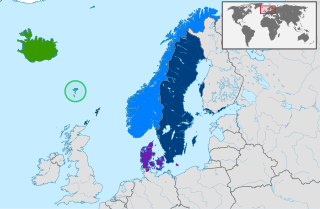
The North Germanic languages make up one of the three branches of the Germanic languages—a sub-family of the Indo-European languages—along with the West Germanic languages and the extinct East Germanic languages. The language group is also referred to as the Nordic languages, a direct translation of the most common term used among Danish, Faroese, Icelandic, Norwegian, and Swedish scholars and people.

The West Germanic languages constitute the largest of the three branches of the Germanic family of languages. The West Germanic branch is classically subdivided into three branches: Ingvaeonic, which includes English and the Frisian languages; Istvaeonic, which encompasses Dutch and its close relatives; and Irminonic, which includes German and its close relatives and variants.
Old Norwegian, also called Norwegian Norse, is an early form of the Norwegian language that was spoken between the 11th and 14th century; it is a transitional stage between Old West Norse and Middle Norwegian.
A-mutation is a metaphonic process supposed to have taken place in late Proto-Germanic.

In historical linguistics, the High German consonant shift or second Germanic consonant shift is a phonological development that took place in the southern parts of the West Germanic dialect continuum in several phases. It probably began between the 3rd and 5th centuries and was almost complete before the earliest written records in High German were produced in the 8th century. From Proto-Germanic, the resulting language, Old High German, can be neatly contrasted with the other continental West Germanic languages, which for the most part did not experience the shift, and with Old English, which remained unaffected.

The Anglo-Frisian languages are the Anglic and Frisian varieties of the West Germanic languages.
Dutch is a West Germanic language, that originated from the Old Frankish dialects.

Franconian or Frankish is a collective term traditionally used by linguists to refer to many West Germanic languages, some of which are spoken in what formed the historical core area of Francia during the Early Middle Ages.
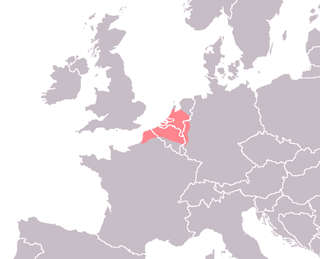
In linguistics, Old Dutch or Old Low Franconian is the set of dialects that evolved from Frankish spoken in the Low Countries during the Early Middle Ages, from around the 6th or 9th to the 12th century. Old Dutch is mostly recorded on fragmentary relics, and words have been reconstructed from Middle Dutch and Old Dutch loanwords in French.

The languages of Scotland belong predominantly to the Germanic and Celtic language families. The main language now spoken in Scotland is English, while Scots and Scottish Gaelic are minority languages. The dialect of English spoken in Scotland is referred to as Scottish English.
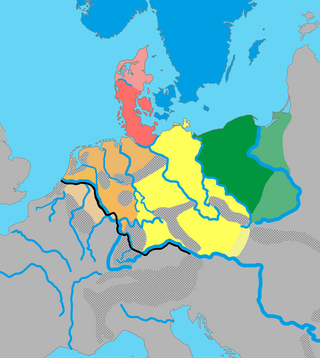
In historical linguistics, the Ingvaeonic nasal spirant law is a description of a phonological development that occurred in the Ingvaeonic dialects of the West Germanic languages. This includes Old English, Old Frisian, and Old Saxon, and to a lesser degree Old Dutch.












